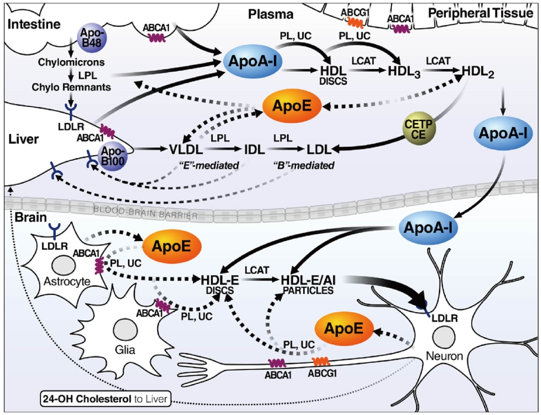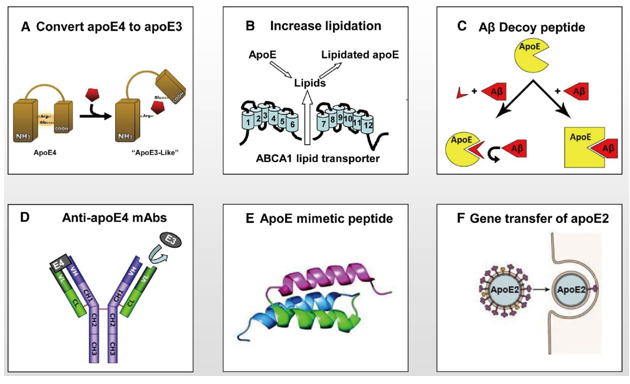
Our promise to you:
Guaranteed product quality, expert customer support.
 24x7 CUSTOMER SERVICE
24x7 CUSTOMER SERVICE
 CONTACT US TO ORDER
CONTACT US TO ORDER
ApoE Gene Editing 
Apolipoprotein E (apoE) is a glycoprotein of 299 amino acids with a molecular mass of ∼34 kDa. It was originally identified as an apolipoprotein enriched on cholesterol- and triglyceride-rich plasma lipoprotein that is synthesized by the liver in animals and humans. ApoE mediates the transport and delivery of cholesterol and other lipids by cell surface apoE receptors. Three ApoE isoforms exist in humans: ApoE2, ApoE3, and ApoE4, which differ from one another through single amino acid substitutions at positions 112 and 158, ApoE2 (Cys-112, Cys-158), ApoE3 (Cys-112, Arg-158), and ApoE4 (Arg-112, Arg-158). Substitution of cysteine at position 158 in ApoE2 leads to hypocholesterolemia caused by low levels of low-density lipoprotein (LDL), cholesterol. In contrast, the substitution of cysteine with arginine at position 112 in ApoE4 leads to elevation of LDL levels and plasma cholesterol and predisposes the carrier to cardiovascular disease and neurodegenerative disorders, including Alzheimer's disease (AD).
Functions of ApoE in the brain
The primary function of apoE in the brain is to traffic cholesterol and other lipids. Though it is expressed in several peripheral tissues, apoE is most highly expressed in the liver and brain. In the brain, apoE is the primary apolipoprotein that associates with high-density lipoprotein-like lipoproteins, the only lipoprotein assembly, meaning that apoE plays an important role in maintaining neural functions dependent on cholesterol, in addition to other roles. Indeed, a significant body of work shows apoE involvement in synaptogenesis, neurite outgrowth, and dendritic arborization, modulation of synaptic plasticity, neurogenesis, and neuroinflammation, often with isoform-specific efficacy.
 Figure 1. The major pathways of plasma lipoprotein metabolism in the peripheral circulation and lipoprotein pathways in the brain. (Mahley R W. 2016)
Figure 1. The major pathways of plasma lipoprotein metabolism in the peripheral circulation and lipoprotein pathways in the brain. (Mahley R W. 2016)
ApoE4 and Alzheimer's disease
Much evidence has indicated that APOE4 is the strongest genetic risk factor for AD, because APOE4 significantly increases the risk for both early-onset AD and late-onset AD. ApoE is deposited in neuritic plaques and neurofibrillary tangles. These deposits appear more widely in AD patients that carry the APOE ε4 allele than in subjects who carry other APOE alleles. Besides, the allele APOE ε4 is associated with elevated brain levels of soluble oligomeric Ab. The allele APOE ε4 is also associated with impaired synaptic plasticity in AD and with increased hippocampal atrophy which is accompanied by loss of dendritic spines. Furthermore, PET studies showed that the brain's glucose metabolism is specifically decreased in distinct brain areas of APOE ε4 carriers and that this metabolic impairment develops at an early stage of the disease. Brain inflammation, which is one of the characteristics of AD, is more pronounced in AD patients who carry the APOE ε4 allele than in non-carriers, and it has been reported that anti-inflammatory drugs reduce the risk for AD specifically in APOE-ε4 carriers. APOE ε4 also has a direct pathological effect on the cerebrovascular system, which together with the neuronal and inflammatory system, represents a pathological triangle of interacting targets.
ApoE4-targeted therapeutic approaches
Several approaches have been developed to counteract the pathological effects of apoE4 in vivo. Both the gain of toxicity approaches, which are directed at either the removal or neutralization of apoE4, and the loss of function approaches, directed at the compensatory reversal of loss of effects of apoE4, have been shown to be effective. This indicates that the pathological effects of apoE4 are driven by more than one mechanism. Thus, the relative impact of such mechanisms may be context-dependent. Consequently, the anti-apoE4 treatment may need to be tailored accordingly.
 Figure 2. ApoE4 directed therapeutic approaches. (Michaelson D M. 2014)
Figure 2. ApoE4 directed therapeutic approaches. (Michaelson D M. 2014)
APOE Gene Editing Service
CRISPR/Cas9 PlatformCB, one of the leading biotechnological companies specializing in gene editing, is dedicated to offering comprehensive CRISPR/Cas9 gene-editing services to a wide range of genomics researchers. Based on our platform, we can help you effectively ApoE gene deleted, inserted or point mutated in cells or animals by CRISPR/Cas9 technology.
- ApoE Gene Knockout: We offer ApoE gene knockout cell line and knockout animal model generation service with high quality. Typically, we develop CRISPR-mediated gene editing cell lines including HEK239T, Hela, HepG2, U87, but we can use other cell lines according to your requirements. Our one-stop KO animal model generation service that covers from sgRNA design and construct, pronuclear microinjection to Founders genotyping and breeding.
- ApoE Gene Knockin: CRISPR/Cas9 PlatformCB provides the one-stop ApoE knock-in cell line and knockout animal model generation services, including point mutation and gene insertion. Our expert staff has succeeded in dozens of ApoE knock-in cell line generation projects, including stem cells, tumor cells and even difficult-to-handle cells. We also have extensive experience in incorporating CRISPR/Cas9 technology into animal models, which have been fully recognized by our clients.
If you have any questions, please feel free to contact us.
Related Products at CRISPR/Cas9 PlatformCB
| CATALOG NO. | PRODUCT NAME | PRODUCT TYPE | INQUIRY |
| CLKO-1031 | APOE KO Cell Lysate-HEK293T | Knockout Cell Lysate | Inquiry |
| CSC-RT0130 | ApoE Knockout Cell Line-LLC-MK2 | Pre-Made Knockout Cell Line | Inquiry |
| CSC-RT0484 | APOE Knockout Cell Line-293T | Pre-Made Knockout Cell Line | Inquiry |
| CSC-RT1202 | Human APOE Knockout Cell Line-HEK293T | Pre-Made Knockout Cell Line | Inquiry |
References
- Riedel B C, et al. Age, APOE and sex: triad of risk of Alzheimer's disease. The Journal of steroid biochemistry and molecular biology, 2016, 160: 134-147.
- Wolf A B, et al. APOE and neuroenergetics: an emerging paradigm in Alzheimer's disease. Neurobiology of aging, 2013, 34(4): 1007-1017.
- Michaelson D M. APOE ε4: The most prevalent yet understudied risk factor for Alzheimer's disease. Alzheimer's & Dementia, 2014, 10(6): 861-868.
- Mahley R W. Central nervous system lipoproteins: ApoE and regulation of cholesterol metabolism. Arteriosclerosis, thrombosis, and vascular biology, 2016, 36(7): 1305-1315.
- Kanekiyo T, et al. ApoE and Aβ in Alzheimer's disease: accidental encounters or partners?. Neuron, 2014, 81(4): 740-754.